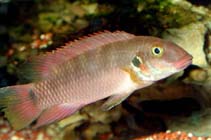| Family: |
Cichlidae (Cichlids), subfamily: Pseudocrenilabrinae |
| Max. size: |
6.52 cm SL (male/unsexed) |
| Environment: |
benthopelagic; freshwater |
| Distribution: |
Africa: only known from the Badi River (Kolente River basin) in Guinea (Ref. 52307, 53266, 93865). |
| Diagnosis: |
Description: slender, elongated body with a fairly long snout, although somewhat shorter than in P. humilis and P. signatus; caudal fin rounded in both sexes (Ref. 52307).
Coloration: Body reddish-brown in males, more yellowish-brown in females; 7 dark vertical bars visible on body in most situations, although these may rarely disappear; dark longitudinal stripe rarely visible, running along mid-body; dark spot on caudal peduncle present in both sexes during most situations, as are dark margins on body scales (always more visible in males than in females); males with reddish snout and lips and without patterns (dots or maculae) in the fins, which are also normally reddish (mainly at their base); in some females, 1-2 black spots on dorsal fin; both sexes with blue to green iridescent worm-like lines on cheeks and opercles, which may sometimes extend over an even greater area; females with rosy to violet belly with an iridescent yellow to turquoise anterior region (Ref. 52307). |
| Biology: |
No information on breeding behavior in the wild; in aquaria it is pair-bonding and cave-breeding (Ref. 52307, 53266). |
| IUCN Red List Status: |
Not Evaluated (N.E.) Ref. (130435)
|
| Threat to humans: |
harmless |
Source and more info: www.fishbase.org. For personal, classroom, and other internal use only. Not for publication.

